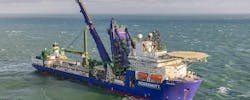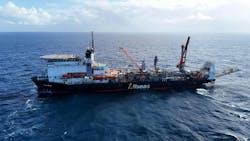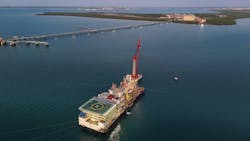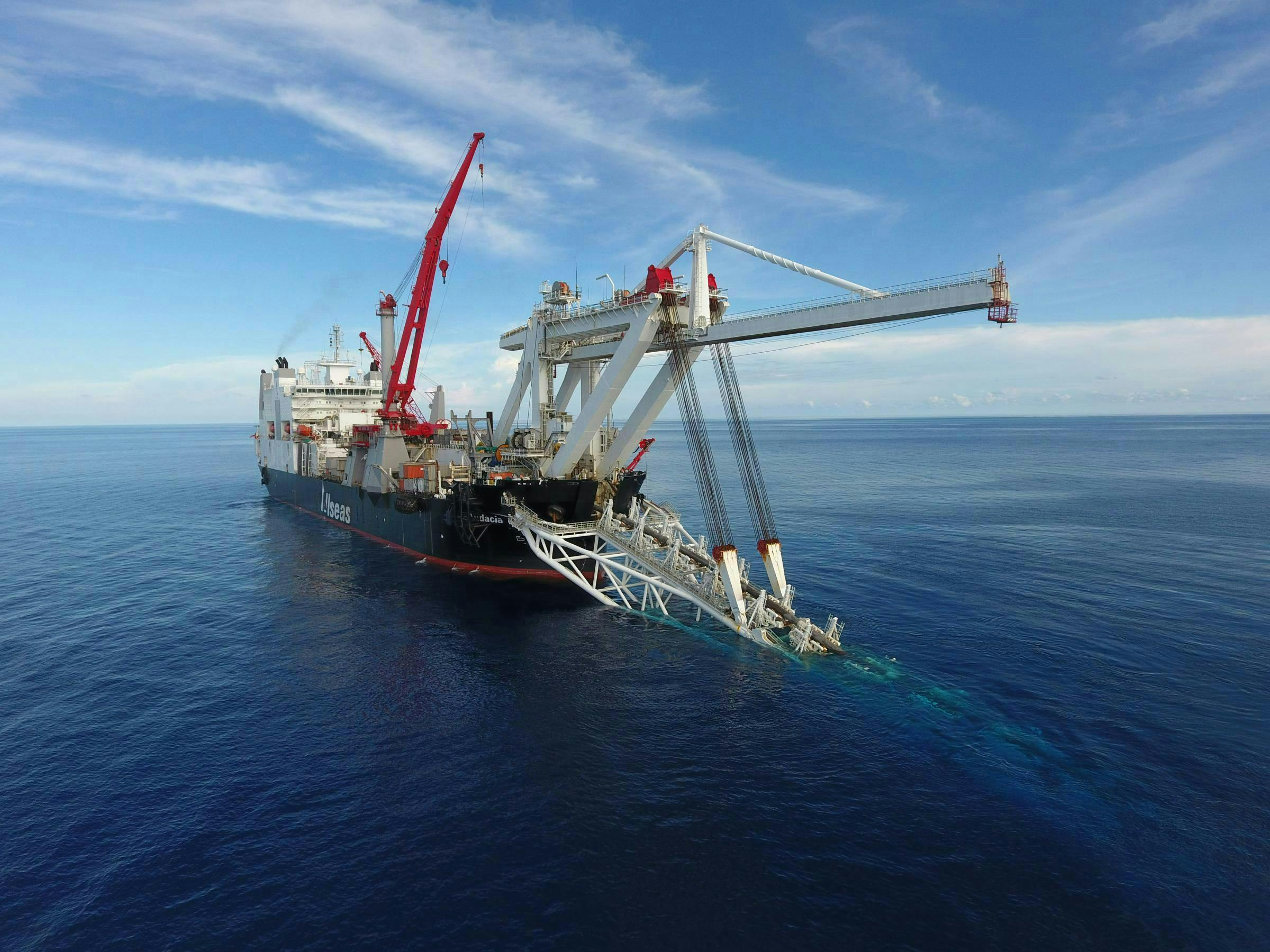By Ariana Hurtado, Editor-in-Chief
Key players like Allseas, Saipem, McDermott and Subsea7 have been making headway on offshore pipeline construction and installation projects, with more on the horizon. Allseas seemingly leads the pack with its vessels completing several pipelaying operations across the globe in the first few months of the year, with Saipem not far behind, announcing numerous project contracts recently.
The following is a compilation of the latest offshore pipeline project updates.
Pipeline installations offshore Mexico
Kicking off the year, Allseas completed the offshore pipelay for the Southeast Gateway pipeline project in southeast Mexico in early January. The work scope included installation of a 700-km, 36-inch natural gas pipeline for TC Energy.
Allseas said it delivered the pipeline in 11 months, which included the nearshore scope and pre-commissioning of the entire system. The company's Solitaire vessel laid the majority of the pipeline, with Lorelay and Tog Mor providing support. Pioneering Spirit installed the nearshore section at Coatzacoalcos, without a stinger. Instead, the hanging stinger transition frame served as a "mini" stinger, which Allseas said was a solution designed for the shallow-water depth.
In February, Allseas announced its plan to enhance Solitaire’s pipelay capabilities with a double joint factory (DJF) upgrade, performed by contractor Goriziane. Located at main deck level, the DJF consists of two identical production lines where single 12-m pipe joints are welded into 24-m double joints before entering the main production line. Allseas said this will result in a faster pipelay process, with improved weld quality and consistency. Goriziane will deliver all pipehandling deck equipment, plus the electrical and instrumentation components necessary to power and control the systems. Delivery is scheduled for January 2026, with installation and commissioning to be performed in-house later the same year.
In the Gulf of Mexico, McDermott completed engineering, procurement, construction and installation (EPCI) and commissioning activities for Shell Offshore Inc. to begin oil production at its Whale development. Awarded in 2021 and completed in February, McDermott's North Ocean 102 vessel and the newly upgraded Amazon vessel performed pipelay operations, reaching water depths of nearly 2,800 m (9,100 ft). This included installing about 50 km (30 miles) of pipeline and 15 km (9 miles) of umbilicals connecting five subsea drill centers to the new Whale floating production platform.
McDermott said the Amazon vessel delivered an ultradeepwater pipelay system with "a high-level of automation." The company boasted, in a GoM first, that it installed five 3,350-m-long (about 11,000 ft) steel catenary risers.
Fast-track pipeline project offshore Trinidad
In late January, Allseas' Lorelay pipelay vessel completed a platform-to-platform pipeline project offshore Trinidad in 10 days.
Awarded in mid-2024, the contract work scope entailed Allseas engineering and installing a 22-km, 16-inch multiphase line to meet first gas commitments for an offshore development in 2025. Running at depths of 60-70 m, the concrete-coated pipeline connects a newly installed platform to existing infrastructure. Lorelay began operations in December, placing 139 mattresses to cross and protect existing subsea pipelines. Allseas said it was the first time it deployed the "bowstring" startup method, which connects the pipeline startup head directly to the platform jacket leg.
The vessel then returned to Rotterdam for lifetime extension and to prepare for the Porthos CO2 project.
CCS projects offshore the UK
Allseas is the main offshore contractor for the Porthos CO2 transport pipeline project in the Dutch North Sea. The company's work includes installation, burial and commissioning of 16-inch pipeline connecting the future compressor station, located at the Maasvlakte, with the P18-A platform offshore. The Lorelay vessel began pipelaying operations in late April, with the assistance of the Oceanic offshore construction support vessel.
However, as of May 6, Allseas temporarily suspended offshore work on the Porthos project due to equipment issues on the Lorelay pipelay vessel. Allseas reported that the pipeline was temporarily abandoned, and the vessel sailed to Rotterdam for investigation into the cause of the incident. No personnel on board were harmed, and the company said there was no environmental impact.
For the Porthos carbon capture and storage (CCS) project in Europe, the plan is for pipeline to transport CO2 captured from the industry through the Port of Rotterdam to depleted gas fields in the North Sea. Porthos is a joint venture of Energie Beheer Nederland (EBN), Gasunie and the Port of Rotterdam.
In similar news, Saipem received the final award in December 2024 for two projects, Northern Endurance Partnership (NEP) and Net Zero Teesside Power (NZT), for the development of offshore facilities for the transportation and storage of CO2 of the East Coast Cluster in the UK.
Last year Saipem announced its plans to conduct the EPCI of 143 km of 28-inch offshore pipeline with associated landfalls and onshore outlet facilities for the NEP project and the EPCI of the water outfall for the NZT project. The offshore installation of the pipeline will be performed by Saipem’s Castorone vessel, and the nearshore operations will be performed by the Saipem’s Castoro 10 shallow-water pipelay vessel.
Also in the region, Subsea7 secured a contract in late March from Equinor as technical service provider for the Northern Lights Phase 2 project offshore Norway. Subsea7’s work scope includes EPCI of a 5-km CO2 pipeline and installation of integrated satellite structures, umbilicals, tie-in and pre-commissioning activities. Project management and engineering began immediately at Subsea7’s office in Stavanger, Norway. Fabrication of the pipeline will take place at Subsea7’s spoolbase at Vigra, Norway, and offshore operations are scheduled for 2026 and 2027.
Darwin pipeline project offshore Australia
In late March, Allseas' Sandpiper vessel completed nearshore construction activities for Santos’ Darwin Pipeline Duplication project in the Northern Territory coastal waters of Australia. The company said its crews navigated strong currents and tidal changes up to 8 m to deliver the 32-km shallow-water section, including pull-in to the existing Darwin LNG facility.
"Pipelay was further complicated by the congested nearshore seabed, home to live gas lines, exclusion areas, protected wrecks and potential UXOs, requiring each anchor position to be carefully pre-engineered," Allseas reported. "To overcome the challenges, Sandpiper utilized her fully automatic positioning system to maintain pinpoint accuracy. Designed entirely in-house, the central console serves as the interface for the 10 winches—each spooling 1,500 meters of lightweight, high-strength, self-floating lines—to speed up anchor deployment and improve performance and reliability."
Pipeline installation work offshore Brazil
For Petrobras' Búzios-10 offshore pipeline installation project, Allseas is set to provide the design, procurement, construction and installation of subsea infrastructure for the presalt field, which is about 180 km offshore Rio de Janeiro, Brazil. Allseas said this is one of the largest offshore pipeline installation projects in its 40-year history.
The offshore campaign is scheduled to begin in third-quarter 2026, with the Audacia pipelay vessel installing 111 km of rigid risers and flowlines in ultradeep waters. Operating at depths beyond 2 km, the system will link 16 wells to an FPSO via steel risers configured in a lazy-wave formation. As of late February, Allseas was in the final stages of awarding subcontracts for seamless linepipe manufacturing, internal cladding and flexible joints for the steel catenary risers. In addition, to support its work for this project, the company opened a new project management and engineering office in Rio de Janeiro.
Moreover, Subsea7 secured a contract in May from Petrobras for the development of the Búzios-11 Field, which is in 2,000 m water depth in the presalt Santos Basin. The work scope includes engineering, procurement, fabrication, installation and pre-commissioning of 112-km rigid risers and flowlines system. Project management and engineering have already begun at Subsea7’s offices in Rio de Janeiro, Suresnes and Sutton. Fabrication of the pipelines will take place at Subsea7’s spoolbase in Brazil, and offshore activities are scheduled for 2027 and 2028.
EPCI projects offshore Guyana and the Middle East
In early April, Saipem secured a new contract for EPCI activities for the repair of damaged subsea pipelines for a company in Middle East. The project is expected to last three years.
In addition, the company also was awarded a limited notice to proceed (LNTP) by ExxonMobil Guyana Ltd., pending necessary government and regulatory approvals, that entails the EPCI of subsea structures, umbilicals, risers and flowlines (SURF) for the production facility and gas export system of the proposed Hammerhead oilfield development project in the Stabroek Block offshore Guyana at a water depth of about 1,000 m.
Saipem said the LNTP allows it to start early work activities, specifically detailed engineering and procurement, to ensure an earliest possible project startup in 2029, should the project receive the necessary government approvals. The construction and installation activities provided by the contract is subject to government and regulatory approval as well as project sanction by ExxonMobil Guyana Ltd. and its Stabroek Block coventurers.
Saipem will perform the operations by using a variety of construction and support vessels, including the Saipem FDS2 field development and pipelaying ship. The logistics will be entirely executed and managed in Guyana through the Vreed-en-Hoop Shorebase Inc. (VEHSI) yard. The duration of the project is expected to last four years.
EPCI of platforms and pipelines offshore Indonesia
In November 2024, Saipem and partner PT Meindo Elang Indah were awarded an offshore EPCI contract by BP Berau Ltd. for the Tangguh UCC Project located in Papua Barat Province, Indonesia. The value of the contract is about $1.2 billion, of which Saipem's share amounts to about $1 billion.
The Tangguh UCC project encompasses the production of natural gas resources from the Ubadari offshore field and its transportation to the onshore LNG plant where it will undergo a CO2 separation process. The captured CO2 will then be sent into an offshore platform for reinjection into the reservoir, helping to extract additional natural gas resources, Saipem explained.
Saipem’s work scope includes the EPCI of two wellhead production platforms, a wellhead platform for the reinjection of CO2 and about 90 km of associated pipelines. The platforms will be fabricated locally in Saipem's Karimun yard.
Subsea development offshore Suriname
That same month Saipem was awarded a $1.9 billion EPCI contract by TotalEnergies EP Suriname B.V. for the subsea development of the GranMorgu project in the Block 58 oil and gas field offshore Suriname. Saipem said this will be the first major subsea development in the country. Plans include expanding the production of the block central area through a system of subsea wells connected to an FPSO vessel. The full project is expected to last five years, with first oil in 2028.
Saipem’s scope of work includes the EPCI, supply, pre-commissioning and assistance for the commissioning, and startup of the SURF package. This includes the EPCI of about 100 km of 10- to 12-inch subsea production flowlines, 90 km of 8- to 12-inch water and gas injection lines, and the transport and installation of flexible risers, umbilicals and associated structures, at water depths ranging from 100 m to 1,100 m. For the offshore campaign, scheduled for 2027 and 2028, Saipem will deploy a combination of S-Lay and J-Lay vessels for pipeline installation.
About the Author
Ariana Hurtado
Editor-in-Chief
With more than a decade of copy editing, project management and journalism experience, Ariana Hurtado is a seasoned managing editor born and raised in the energy capital of the world—Houston, Texas. She currently serves as editor-in-chief of Offshore, overseeing the editorial team, its content and the brand's growth from a digital perspective.
Utilizing her editorial expertise, she manages digital media for the Offshore team. She also helps create and oversee new special industry reports and revolutionizes existing supplements, while also contributing content to Offshore's magazine, newsletters and website as a copy editor and writer.
Prior to her current role, she served as Offshore's editor and director of special reports from April 2022 to December 2024. Before joining Offshore, she served as senior managing editor of publications with Hart Energy. Prior to her nearly nine years with Hart, she worked on the copy desk as a news editor at the Houston Chronicle.
She graduated magna cum laude with a bachelor's degree in journalism from the University of Houston.






